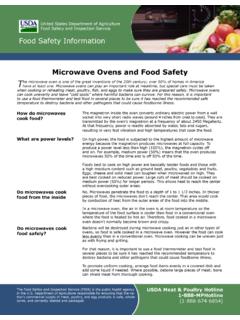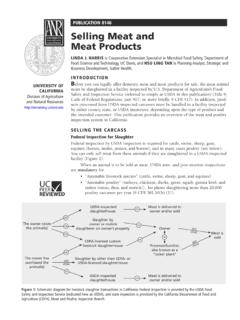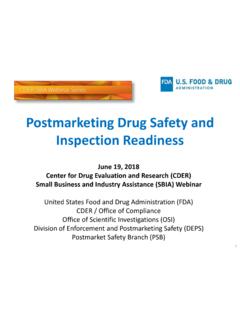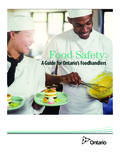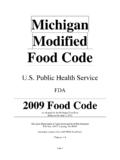Transcription of BULK OVER-THE-ROAD FOOD TANKER TRANSPORT SAFETY …
1 BULK OVER-THE-ROAD . food TANKER . TRANSPORT SAFETY . AND security . guidelines . food Industry Transportation Coalition BULK OVER-THE-ROAD food TANKER . TRANSPORT SAFETY AND security . guidelines . SPONSORING ORGANIZATIONS. AMERICAN BAKERS ASSOCIATION. AMERICAN FROZEN food INSTITUTE. CONCORD GRAPE ASSOCIATION. CORN REFINERS ASSOCIATION. GROCERY MANUFACTURERS OF AMERICA. INSTITUTE OF SHORTENING AND EDIBLE OILS. INTERNATIONAL DAIRY FOODS ASSOCIATION. NATIONAL food PROCESSORS ASSOCIATION. NATIONAL INSTITUTE OF OILSEED PRODUCTS. NATIONAL JUICE PRODUCTS ASSOCIATION. NATIONAL MILK PRODUCERS ASSOCIATION. NATIONAL TANK TRUCK CARRIERS. NORTHWEST food PROCESSORS ASSOCIATION. PROCESSED APPLES INSTITUTE. SNACK food ASSOCIATION. THE VINEGAR INSTITUTE. 2. TABLE OF CONTENTS. I. II. Documentation ..5. and Inspection of Empty A. B. Visual IV. Tank Truck V. Loaded TANKER ..9. A. VI. Minimum Cleaning Requirements for Non-Dairy food , food Grade, Liquid Cargo Tanks.
2 10. A. food to B. food to food Dry Bulk ..10. C. Additional VII. Conversion of A. Minimum Conversion VIII. Tank Requirements ..14. A. Non-Dairy Liquid food Grade B. Accessories and Fittings on Non-Dairy Liquid C. Dry-Bulk food Grade Cargo Tanks ..15. IX. security ..15. A. Trucking B. Driver ..15. C. Cleaning D. Receiving Facility ..16. E. Appendix A Appendix B Inspection Report Form (Loaded TANKER )..19. Appendix C Inspection Report Form (Empty TANKER )..20. Appendix D Wash Facility Audit 3. BULK OVER-THE-ROAD food TANKER . TRANSPORT SAFETY AND security . guidelines . I. INTRODUCTION. Information and recommendations contained in this document are intended as voluntary guidelines for the safe and secure TRANSPORT and handling of OVER-THE-ROAD food tankers . As such, the sponsoring organizations do not guarantee or warrant, expressly or by implication, that compliance with the guidelines will prevent damage, spoilage, accidents, or injuries to persons or property.
3 Any inference of such a guarantee or warranty is expressly and specifically disclaimed. It is the sole responsibility of any company or person using the guidelines and related information provided in this publication, and not the responsibility of the sponsoring organizations, to ensure that such company or person is proficient in the operations and procedures discussed in this publication. The use of statements, recommendations, or suggestions contained herein creates no responsibility on the part of the sponsoring organizations for damage, spoilage, loss, accident or injury resulting from such use, or irrespective of such use. Moreover, adoption of any of the guidelines or recommendations included in this publication does not assure compliance with legal or regulatory requirements. Those involved with the production, handling and transportation of foods are advised to become familiar with all relevant and applicable local, state and federal regulations and to ensure that they comply with such requirements as appropriate.
4 A company policy should be established to designate authorized personnel for acceptance of incoming transportation equipment. The policy document should be maintained in company files in accordance with company policy. In addition to these guidelines , a company may provide employees with additional information and forms for use in acceptance of transportation equipment. Consult your legal counsel for guidance on related legal requirements concerning the transportation of foods. 4. II. DOCUMENTATION. A. RECOMMENDATIONS. 1. The contract and/or verification between a shipper and carrier should include a clause identifying the last three prior cargoes, a copy of the last wash ticket and documentation if the TANKER has been converted from non- food to food grade (See Section VII). 2. The carrier should supply documentation to the shipper confirming that all equipment being used is for food grade purposes. This information should be kept on file at the shipper's office.
5 3. The commodities the carrier may haul in tankers contracted for shipper service are those agreed upon between the parties. 4. A new piece of equipment should have a sanitary cleaning prior to placement in service. 5. Except for dedicated equipment, in-service equipment should have a listing of the last three loads and a copy of the last wash out certificate. 6. If special handling requirements are necessary, they should be specified in the Bill of Lading. Special requirements may include, but are not limited to temperature specifications or restrictions, pumps and nitrogen overlays. III. RECEIPT AND INSPECTION OF EMPTY TANKER . A. RECEIPT. 1. Plant personnel should take all reasonable measures and precautions to assure that plant operators conform to the requirements in 21 CFR 110. (Current Good Manufacturing Practices (CGMPs) and 9 CFR Part 417. (Hazard Analysis Critical Control Point (HACCP) Systems). The loading and unloading areas should be designed and maintained in accordance with Good Manufacturing Practices or appropriate regulations in order to reduce the potential for contamination of the inbound product.)
6 2. The TANKER should be identified for use if there are specific regulation requirements juice, seafood, meat and poultry, etc., and/or if there are specific customer requirements. 5. 3. Confirm that access points were sealed at the wash station with numbered, tamper-evident seals to guard against subsequent contamination of the cleaned trailer before delivery. This should include at least all major points of entry and discharge. Sealing points may include the dome cover, tank outlet, vent cap, pump inlet, pump outlet, and hose tube covers. In the event that transfer hoses and/or the shipper or consignee supplies piping, seals need not be applied to hose tubes mounted on the cargo tank. If seals are present and are broken or tampered with by enforcement personnel, documentation must be produced by enforcement personnel to verify such action. Tank wash facilities, shippers and consignees should be authorized to remove and replace seals.
7 4. Confirm that hoses and pump outlets were capped and sealed at the wash station after cleaning. Trailers hauling food grade commodities should be washed on a regular schedule regardless of whether or not they have hauled food , the interval for which will be determined under the terms of the contract. 5. All documentation, including wash certificates or tags and bills of lading, should be reviewed and seal identification checked and verified. 6. Seal numbers should be recorded on the wash ticket, or a suitable document designed for that purpose, and verified by the receiver when inspecting the vehicle. Any discrepancy should be reported to management immediately. If the driver indicates that it has been necessary to transfer the lading from one tank to another after washing, contact appropriate plant management. 7. Obtain appropriate documentation from the trucker or the truck company concerning the previous cargo(es).
8 (See Section II on documentation) The prior load should be accurately documented and documentation available to assure that the tank has been in acceptable transportation service. Additionally, the trucking company should be able to present independent documentation ( , shipper bills of lading) of the last three prior load commodities (by fax or e-mail), upon request. 8. The cleaning certificate issued by the wash station should contain the name of the product last hauled determined via the last shipping documents and should be reviewed and copied for filing. If no cleaning certificate is presented, management should be consulted. 6. 9. If washing is required, a copy of the wash ticket, noting the prior commodity, should be presented to the outbound truck operator. The carrier should also provide wash schedules/wash histories for a specific cargo tank upon request. 10. The prior load records should be verified as designated in the documentation section of this guideline.
9 If the prior cargo was not an acceptable material, do not accept the load and contact appropriate plant management immediately. B. VISUAL INSPECTION. 1. The interior of the tank should be inspected visually. The interior of the tank should be clean and free of cracks and corrosion, which can harbor contaminants. If condensate is present or the interior is otherwise unacceptable, check with your supervisor prior to loading. Internal damage or corrosion, foreign objects, incompatible product residue, mold, and moisture are potential causes for rejection. 2. The presence of off-odors or of any residual material when opening the dome cover should be reported to appropriate plant management immediately. 3. Inspect the inside of the tank for evidence of residue of prior cargoes or flaking, which indicates inadequate cleaning/rinsing of the tank or unacceptable prior cargoes. Be especially alert to those areas hard to inspect visually, such as the top inner portion of the tank.
10 4. It is recommended that the shippers/receivers use their own pumps and hoses. If the TANKER or tractor pump and hoses are used, they should meet all applicable TANKER guidelines . If the truck's pumping system is to be used for loading, all hoses and pumps should be visually inspected. Special attention should be paid to pumps located on the tractor, as the tractor unit may not be dedicated to food service use and may not have been cleaned when the trailer was cleaned. If pumps and/or hoses carried on the tractor are to be used, they should be indicated as having been cleaned on the wash station certificate. Tractor mounted blowers, used for the transfer of dry commodities should not be cleaned, but move only air. 5. Inspect all seals, gaskets, pumps, valves, hoses, and hose tubing for cleanliness, integrity, and proper capping. Cracked, corroded, or improperly protected equipment can trap [residual material] and serve as a source of contamination or create an environment conducive to bacterial growth with the potential for contaminating product coming in contact with the surface.
